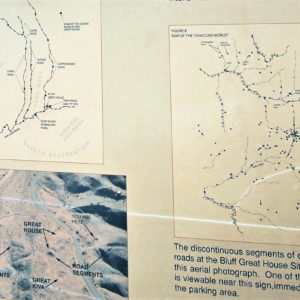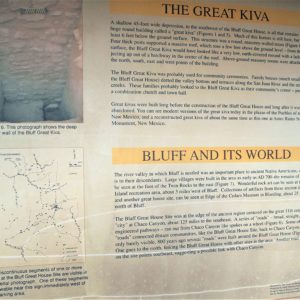The Bluff Great House is one of the ‘outlier’ Chacoan community great houses built by Ancestral Puebloans. The remains of the Bluff Great House are located on Cemetery Hill.
What is Chaco Canyon?
To understand the Bluff Great House, it is important to know about Chaco Canyon and the Chaco era (A.D. 900-1150). Chaco Culture National Historic Park is located between Farmington and Albuquerque, New Mexico. By 1050, Chaco had become the ceremonial, administrative, and economic center of the San Juan Basin. Its sphere of influence was extensive. It is thought that Chaco was not occupied by large populations, but instead may have been a public place used for ceremony, commerce, and trading when temporary populations came to the canyon for events. Pueblo Bonito, for example, an enormous great house in Chaco Canyon, had almost 700 rooms.
Chaco Canyon was also connected by roads to outlying great houses throughout the region. These roads were used for public transportation, but also used to transport goods needed at Chaco. Chaco Canyon collapsed around 1150 A.D.
What is a Great House?
A great house is large, multi-storied Ancestral Puebloan structure. One or more kivas, road segments, and earthen mounds or berms are features found at a great house site.
Bluff Great House
The Great House is one of some 200 Chacoan community great houses scattered across the northern Southwest. Drs. Catherine Cameron and Stephen Lekson from the University of Colorado’s Department of Anthropology led a research project which involved excavation of the Bluff Great House.
The great house was built somewhere between 1075- 1150 A.D., although the location had been in use since 600 – 750 A.D. As with other great houses, the Bluff Great House is in a prominent location on a hill above Bluff where it would have towered over the surrounding community. It faces south overlooking fertile farmland and the San Juan River.
The Bluff Great House was probably used for public and ceremonial space. Other nearby resident dwellings have been found in the vicinity. The structure was multi-storied and had 20 – 40 rooms with four kivas along the front of the great house. The great kiva was around 45 feet across, considered to be a small kiva by southwestern standards.
Earth berms were found, but probably weren’t used for defensive purposes. The berms may have been used to define boundaries, or to separate ‘us’ from ‘them.’
Several prehistoric roads have been found that pass through gaps in the berm. One road points southeast towards Chaco Canyon. Another road points in the direction of Comb Ridge, a daunting rock monocline which would have been difficult to Ancestral Puebloans to cross. Researchers found the road leads to a place where steps have been pecked into the Comb Ridge sandstone.
Researchers question whether Bluff was built by Chaco peoples as a frontier political outpost of Chaco Canyon, or rather by Bluff people attempting to emulate the religious and social system of Chaco Canyon. After Chaco fell, the Bluff Great House was used and reconstructed during the post-Chaco era before being abandoned in 1250 A.D.
Bluff Great House Site Today
The Bluff Great House site is privately owned by the Southwest Heritage Foundation. Visitors can travel to the site and view an informational sign.
Source: Ward, Christine “The Bluff Great House” Expedition Magazine 45.3 (2003); n. pag. Expedition Magazine. Penn Museum, 2003 Web. 13 Dec 2019.





